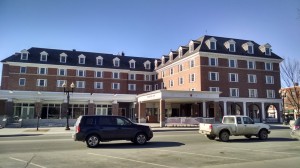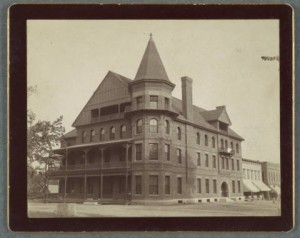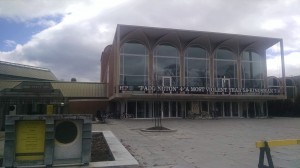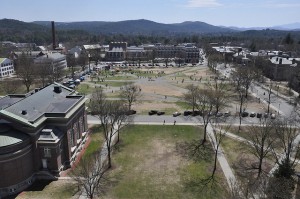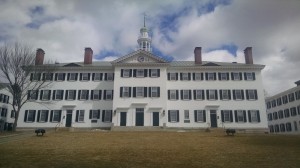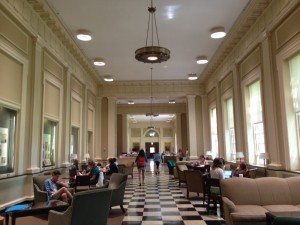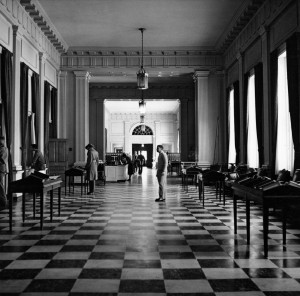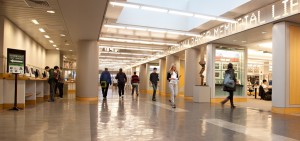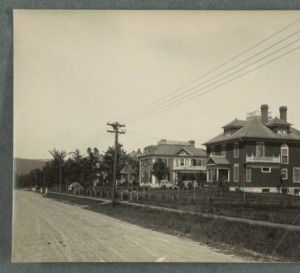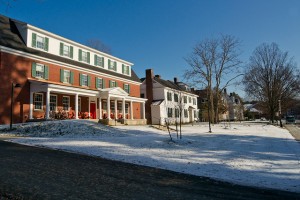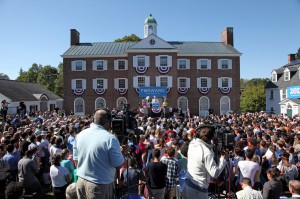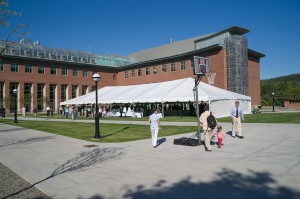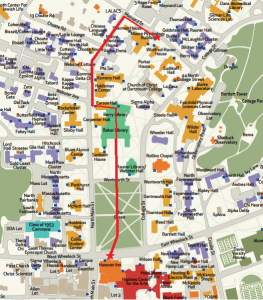 Overview
Overview
Dartmouth College was founded in 1769 by Eleazer Wheelock, a puritan minister who wished to educate local Native Americans in reading, writing and Christianity. The college was established in the town of Hanover, New Hampshire, which had been chartered only eight years before. The college was situated next to the Common of the village named the Plain, for the extensive surrounding area of level land. Since then, both the town and college have grown extensively, with the population of Hanover topping eleven thousand residents, and the college totaling over six thousand students. Hanover itself can be reached just off of I-91 at exit 13. As you go through the tour take note of the landscape and structures and how, as the school has grown, the organization of the campus and the land it occupies has evolved significantly.
Hanover Inn
The first stop of the field trip is at the iconic Hanover Inn, located on the corner of Main and E Wheelock St, which overlooks the college Green. The Inn, originally called the Dartmouth Hotel, was founded in 1780 by General Ebenezer Brewster. The Inn grew over time as more people began living in and visiting Hanover and Dartmouth. The Inn suffered one fire and underwent several renovations during its transition from a house to its current state today. It now holds the record for the oldest continuous business in the entire state. The patrons of the Inn range from parents of students to alumni to visiting professors, and the Inn is vital in accommodating the large number of visitors that come to Dartmouth.
The Hop and the Hood
If you turn to the left of the Hanover Inn you will see the Hopkins Center for the Arts and the Hood Museum of Art, where students, residents, and visitors alike can see live performances and art from around the world. The Hop, as it is commonly called, opened in 1962 and resembles the famed Lincoln Center in New York City; the Hop’s opening, however, actually preceded the Lincoln Center. The Hood building was completed in 1985, but the college collections have been built up since 1772 and now total about 65,000 pieces. The Inn, the Hop, and the Hood mark a meeting point between the town and campus. While the Hop and Hood buildings serve both Dartmouth and the town, as you cross the street you will notice that most buildings are college-owned buildings used primarily by Dartmouth students.
The Green
Cross the street from the Hop and you will find yourself on the college Green, the central hub of the campus from which everything else expands. The quadrangle design originally comes from Oxford and Cambridge, and is now found throughout most college campuses in the U.S. When Dartmouth and Hanover were still young, the Green, known as the Common, was utilized to hold town meetings and to graze cattle. Then, in the late 19th century it was fenced in by the college to discourage public use. Today, the Green is open to the public, but still remains an area dominated by Dartmouth students during the school year.
Dartmouth Hall
As you continue to walk away from the Hop and the Hood and stop in the middle of the Green you will see Dartmouth Hall to the right, one of the first buildings at the college. The original was built in 1784, but suffered several fires and was rebuilt using the original plans. It, along with the surrounding buildings that can be recognized by their similar design, served as both the academic and housing buildings for the college in its early years. Despite the fires, Dartmouth Hall remains very similar in appearance from when it was originally built. Very little material remains from the original hall, except for the beautiful granite steps.
Collis and others
If you look to the southwest corner of the the Green, you will see a row of brick buildings with stone highlights, which are some of the few examples of Romanesque architecture on campus. These buildings were all built at approximately the same time, around the year 1910. Most of these buildings are now used for administrative purposes, except for Collis, the southernmost one with large stone pillars. Collis was originally an academic building, but a donation was given in the 1970’s to turn it into a student center. Today, it houses a café and several social and study spaces.
Baker Library
If you continue across the Green to the north you will come upon Baker Library. While the Green is the physical center of the campus, Baker is the academic center on campus. Constructed in 1928, the library was modeled after Independence Hall. It was named after Fisher Ames Baker, the uncle of George Fisher Baker, who donated the money to construct the building.
For many years the lobby of Baker Library held card catalogs, but today is home to couches, chairs, and tables for collaborative work, along with various artifacts of Dartmouth history. In the basement, you can find the Orozco mural room; upstairs, there are several conference rooms and the Tower Room. Furthermore, if you are looking for food, Baker Library recently added a small, outsourced café known as King Arthur Flour.
After walking through Baker Library, you will pass the “stacks,” which contains over six floors of hundreds of thousands of volumes, along with individual workspaces. It will become apparent as you walk past the stacks that you are entering the newer addition to the library.
Berry Library
From 1928 until 2000, Baker underwent several additions and renovations until the Berry section of the library was officially added. The Berry section of the library brought with it several new study spaces, additional computer areas, classrooms, a café, and most importantly, increased book capacity. The second floor of Berry is home to the Jones Media Center and Evans Map Room, while the third and fourth floors have many spaces to work quietly.
If you take the stairs down in Berry you will see Novack Café, owned and operated by Dartmouth. This is the most social space in the library and contains several meeting rooms too.
Webster Avenue
As you exit the library and turn to the left you will come to Webster Avenue. Webster Avenue is home to the social center of campus.
This street is home to many of Dartmouth’s fraternities and sororities. In the 1920s, with the expansion of the Greek system at Dartmouth, and across the country, Webster Avenue, became home to several fraternities and sororities. Each house is built in its own unique style. At the end of the street, farthest from the library, is the president’s house.
Cutter-Shabazz “Quad”
If you walk past Webster Avenue towards the northern end of campus, there is smaller quadrangle with several buildings on its surroundings to your left. This area contains the Cutter-Shabazz building (which is modeled after the Baker Library), surrounded by the Sustainable Living Community, Webster Cottage and Choate House. The area resembles the Green, with Cutter Shabazz in place of Baker Library and the surrounding buildings taking the place of the building around the Green.
Webster Cottage is actually the oldest standing building at Dartmouth today. The cottage was built in 1780 and was the home of many inhabitants, including Daniel Webster. Today, it is currently home to the Hanover Historical Society. If you would like to visit, it is open on Wednesdays and Saturdays from 2:30 to 4:30.
Choate House, built in 1786, was originally where Webster Hall stands today. The building was moved several times and at one point housed the math department. Originally, Cutter-Shabbaz was built for the Clark Preparatory School in 1953 but was bought by Dartmouth several years later. Today it is home to the African-American Society; the Society hosts various events throughout the year, such as cookouts, dances, and speakers.
The Sustainable Living Community is an LLC, a Living Learning Community. These communities focus on placing Dartmouth students with others who share similar interests and wish to combine their academic experience with their social and living environment at Dartmouth. These communities’ focuses range widely, from language and culture to strictly academic interests such as Math or Computer Science.
Geisel School of Medicine
Lastly, if you continue down North Main Street St. you will eventually run into the intersection with Maynard St. You may end your tour here, or you can finish by visiting the Medical School.
The Geisel School of Medicine is the fourth oldest medical school in the country, founded in 1797. Its location is of particular interest. While still on the campus, the school is on the very outskirts. This is consistent with the other graduate schools on Dartmouth’s campus, Tuck and Thayer. Additionally, as codes and safety regulations are constantly being updated, science/medical buildings must undergo renovations. As a result, most science and engineering buildings at colleges around the country are found in newer buildings on the outskirts of the camps. At Dartmouth, the Geisel School of Medicine fits this trend, as it is the most northern building on campus.
I hope you enjoyed the tour and please return sometime soon!


